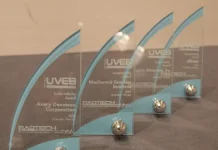By Dianna Brodine, managing editor, UV+EB Technology
 SAE World Congress was renamed in 2018, now branded as WCXTM18: SAE World Congress Experience. Held April 9 through 11 at the Cobo Center in Detroit, Michigan, the event was billed as the place “where collaboration and imagination converge to create new solutions for common industry challenges. Where expertise and experience across the wide spectrum of specialties forge best practices. And where education, engagement and enlightenment coalesce into one unforgettable experience.”
SAE World Congress was renamed in 2018, now branded as WCXTM18: SAE World Congress Experience. Held April 9 through 11 at the Cobo Center in Detroit, Michigan, the event was billed as the place “where collaboration and imagination converge to create new solutions for common industry challenges. Where expertise and experience across the wide spectrum of specialties forge best practices. And where education, engagement and enlightenment coalesce into one unforgettable experience.”
The event boasted more than 1,000 hours of technical sessions from which to choose. Amidst all this, representatives from RadTech International North America assisted with organizing a full day of programming related to coatings. Eight of the 12 papers presented were on UV technology applications.
Chairs for the session included Mary Ellen Rosenberger, BaySpring Solutions LLC and Christopher Seubert, Ford Motor Co, Ltd., with assistance from Michael J. Dvorchak, Dvorchak Enterprises LLC.
“The coatings sessions averaged 35 people in attendance per session, which is an increase from previous years,” said Dvorchak. “The papers on coatings weren’t going to be enough to fill the session until RadTech approached organizers and brought eight UV-related papers.”
Four coatings papers, including those on automotive sensors and coating scratch resistance, rounded out the sessions. “This is the 3rd year of the event with a UV session and the first year we were combined with the coatings session,” added Seubert. “It was good to have these other coating technologies as a prelude to what we were talking about – it integrated nicely.”
Paper topics presented included Energy-Curable Coatings for Automotive Interior; UV-Curable Paint for Automotive Interior Plastic Parts; Shark Skin Antimicrobial Surfaces for Future Autonomous Vehicles; Innovations in 3D Printing Materials for Additive Manufacturing; The Unique Chemistry of Waterborne UV Curable Resins on Flexible Substrates; UV Coatings for Automotive Use; Innovations in 3D Printing Materials for Additive Manufacturing; and Additive Manufacturing of Low-Density UV-Curable Resins to Produce Lightweight Structures for Automotive Applications.
“From my perspective, what was nice was having a group of people in the audience with expertise that covered all of the disciplines – from raw material suppliers and paint companies to end users,” said Dvorchak. “There was a similar mix with the presenters. Having these papers in the same session gave us all the opportunity to be exposed to topics we might not have seen at another conference.”
According to Seubert, the automotive-centric focus of WCX18 provides an avenue for different parts of the supply chain to meet. “When you want to talk to the automotive industry, this is the place to go,” he explained. “The sessions by RadTech members introduce people to the UV/EB industry as a whole. At times, the UV community preaches to itself, so it’s nice to have this exposure to the automotive industry where we can meet new people and talk about the technology.
Dvorchak agreed: “It’s giving us a chance to show people the technologies and the intimate workings of what UV/EB can and cant do. Many of the attendees may not have gotten an opportunity to do a deep dive into the technology before listening to one of the RadTech presenters.”
The session chairs were pleased with the interest and participation from audience members. They reported lively question and answer exchanges after each paper.
RadTech hopes to continue its participation in future WCX events.





